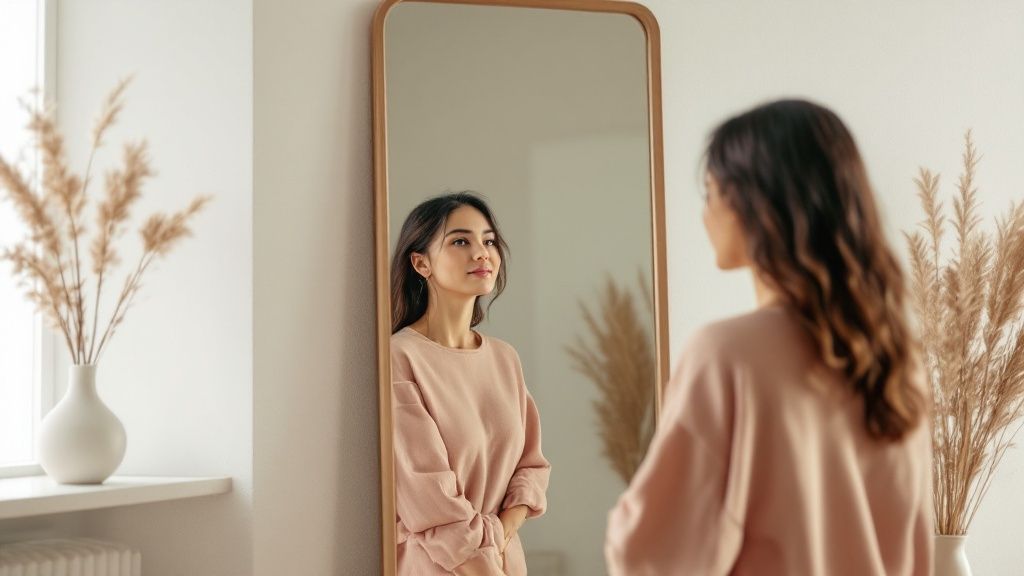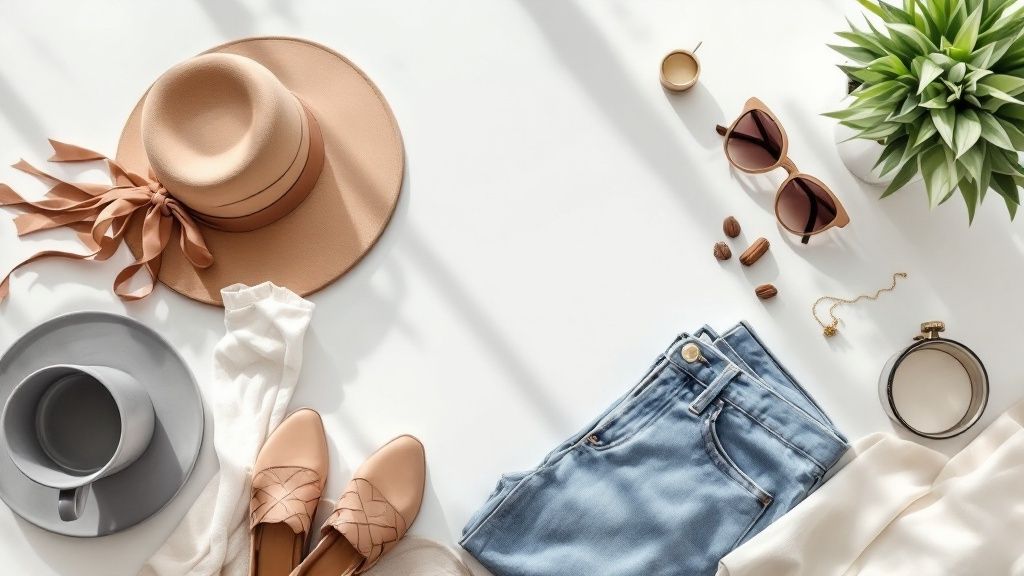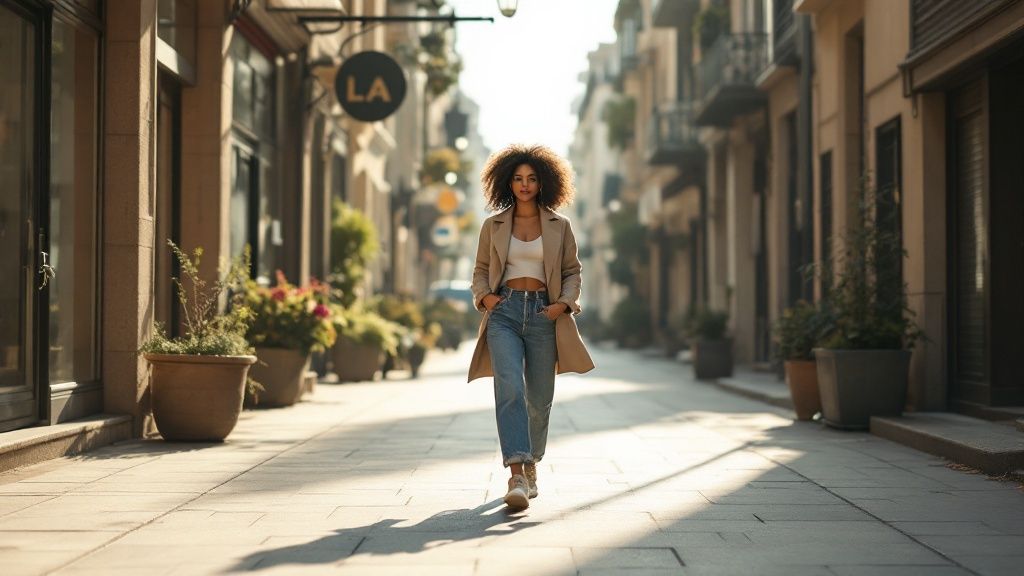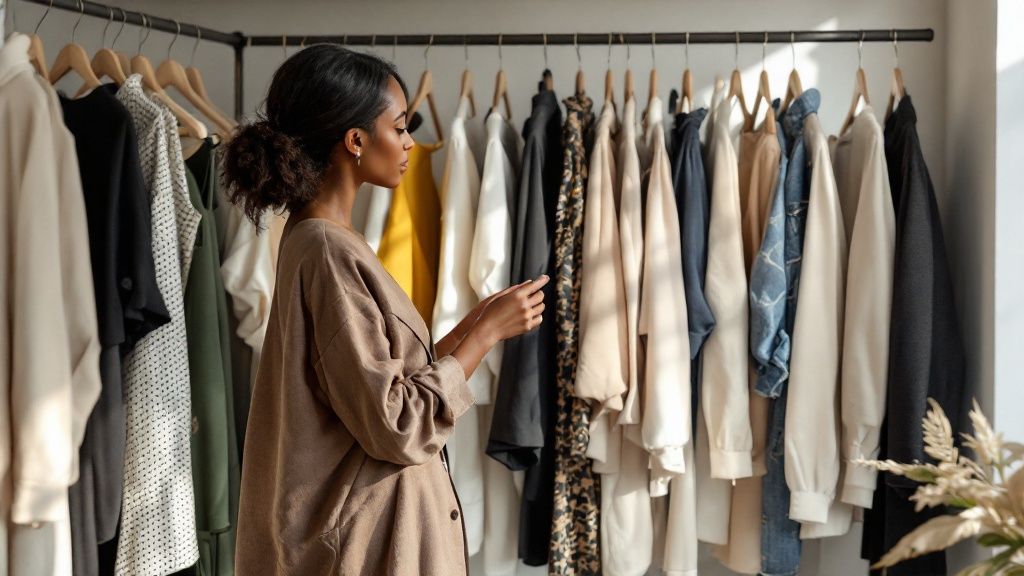Why Finding Your Personal Style Actually Matters
Finding your personal style is more than just looking good. It's about cultivating self-assurance and authentic self-expression. It's about wearing clothes that empower you and make you feel comfortable – clothes that truly represent you. This confident self-expression becomes a powerful visual statement, communicating who you are before you even say a word.
Confidence Boost and Self-Expression
Think of personal style as a visual language. When your outward appearance aligns with your inner self, it creates a deep sense of confidence. This isn't about chasing trends; it's about curating a wardrobe that reflects your personality and values. Someone who values comfort and practicality might prefer minimalist, functional pieces. Someone with a bold, artistic spirit might embrace vibrant colors and unique silhouettes. Finding your personal style empowers you to present your best self. You might be interested in: How to master…
Decision Fatigue and Consistent Self-Presentation
A defined personal style simplifies daily life. Imagine opening your closet and instantly knowing what to wear because everything reflects your taste. This eliminates decision fatigue, freeing up mental energy. It also creates a consistent self-presentation, reinforcing your identity in personal and professional settings. This consistency builds confidence and lets your personality shine.
The Impact of Style Choices
Global apparel consumption highlights the growing importance of personal style. In 2021, people bought an average of 16.7 clothing/footwear items annually, spending $220.70 per person. While China led in unit purchases, per capita spending shows developed markets invest more in curating personal style. This spending is projected to reach $247.40 per person globally in 2023. This investment demonstrates how much people value cultivating a unique aesthetic. Find more detailed statistics here: Global Fashion Industry Statistics
Developing a strong personal style is an investment in yourself. It's a journey of self-discovery that empowers you to express your authentic self, build confidence, and navigate the world with assurance. This intentional approach to style transforms not just your appearance, but your mindset and how others perceive you.

Decoding Your Current Closet: What It Reveals About You

Your current wardrobe holds a wealth of knowledge about your personal style, even if it’s not something you’ve actively explored before. It's a direct reflection of your past clothing choices and a valuable tool for understanding what you truly love to wear. This section will guide you through a positive and insightful closet audit, helping you uncover hidden patterns and preferences. This journey of self-discovery is key to defining your personal style.
Identifying Your Go-To Pieces
Begin by pinpointing your go-to pieces. These are the clothes you instinctively reach for when you want to feel comfortable, confident, or simply put-together. Take a moment to consider what these items have in common. Do you gravitate towards particular colors, fabrics, or silhouettes? This initial analysis provides valuable clues about your inherent style preferences, even those you haven't consciously recognized.
Analyzing the Unworn Items
Next, turn your attention to the clothes you don't wear. Why are they taking up space in your closet? Are they uncomfortable, ill-fitting, or have you simply outgrown them stylistically? Understanding why some items remain unworn is just as important as identifying your favorites. This helps you avoid making similar purchases in the future and clarifies your understanding of what truly flatters your figure and reflects your personality.
Documenting Your Findings: A Style Journal
To develop a more in-depth understanding, try documenting your fashion choices. A simple style journal can be a powerful tool. Jot down what you wear each day, the reasons behind your outfit choice, and how it made you feel. Over time, patterns will emerge, revealing your preferences for specific styles, colors, and even the emotional connections you associate with particular garments. This mindful approach to dressing can be incredibly revealing.
Categorizing Your Wardrobe: A Practical Framework
Another effective strategy is categorizing your current wardrobe. This provides a clear snapshot of your existing pieces and can uncover any imbalances or gaps. Perhaps you’ll discover an overabundance of casual wear and a shortage of formal attire, or vice versa.
This awareness allows for more intentional shopping decisions. You can then prioritize purchases that genuinely align with your lifestyle and evolving sense of style. A well-balanced wardrobe ensures you’re prepared for any occasion and reflects your growing understanding of what you love to wear.
To give you a structured way to analyze your clothes, we’ve created the Wardrobe Analysis Framework. This table provides a helpful set of questions, action steps, and insights to guide your evaluation.
| Category | Questions to Ask | Action Steps | What It Reveals |
|---|---|---|---|
| Frequently Worn | What do I reach for most often? What makes these items so appealing? | Take photos and note down common features (color, fabric, silhouette). | Your core preferences and comfort zone. |
| Never Worn | Why haven't I worn these items? Do they no longer fit my style or lifestyle? | Try them on and honestly assess why they don't work. Consider donating or selling. | Styles that don't resonate with you, helping you avoid similar purchases. |
| Special Occasion | How often do I wear these items? Do they still fit and make me feel good? | Assess their current relevance and consider updating or replacing outdated pieces. | Your preferences for formal wear and how they align with your evolving style. |
| Seasonal | Are these items still in good condition? Do they still fit my current style? | Store out-of-season clothes properly and assess their relevance when the season returns. | Your seasonal style preferences and potential areas for updating your wardrobe. |
By working through this framework, you’ll gain valuable insights into your existing wardrobe and a clearer understanding of your style preferences. The key takeaway here is that your closet isn't just a storage space; it’s a reflection of your personal style journey.
By analyzing your current closet, you're essentially conducting a personal style investigation. This process is fundamental to creating a wardrobe that authentically reflects who you are. These insights form the building blocks of a personal style that is truly your own.
Gathering Inspiration That Actually Resonates With You

Finding your personal style isn't about blindly following trends. It's about curating inspiration that truly speaks to you. This means looking beyond overflowing Pinterest boards and generic fashion magazines. Instead, build a focused collection of influences that reflect your unique aesthetic. This section will explore how to discover inspiration that resonates deeply, helping you define a personal style that feels authentic and enduring.
Curating Your Digital Mood Board
Digital mood boards are invaluable for collecting and organizing visual inspiration. However, they can quickly become overwhelming. Instead of endless scrolling, focus on intentional curation.
Create separate boards for different aspects of your style:
- Everyday wear
- Work attire
- Special occasion looks
This organization allows you to pinpoint your preferences within specific contexts. For example, your everyday style might lean towards casual comfort, while your work attire may require a more polished aesthetic.
Looking Beyond the Obvious: Expanding Your Inspiration
Fashion magazines and social media like Instagram are great starting points. However, true style inspiration can be found everywhere. Consider architecture, film, art, and even cultural touchpoints. A sleek, minimalist building might inspire a streamlined wardrobe. A vibrant piece of artwork could influence your color palette.
This broader perspective enriches your understanding of aesthetics. It helps you identify the underlying elements that truly resonate with you. The global AI-based personalized stylist market is also expanding rapidly. It's projected to grow from a $101.5-$127.1 million valuation in 2024 to a staggering $2.8-$2.9 billion by 2034. This growth, driven by a 36.5-38.3% annual rate, reflects the increasing demand for personalized style guidance through AI tools. Learn more about AI-powered styling. This means technology is increasingly influencing how we discover and refine our personal style.
Identifying Style Influencers Who Align With Your Values
Social media is saturated with style influencers. Finding those who genuinely inspire you requires a discerning eye. Look for individuals whose style feels authentic and aligns with your values. Do they prioritize sustainability? Do they embrace body positivity?
Connecting with influencers who resonate on a deeper level ensures your inspiration is meaningful and reflects your personal beliefs. This approach creates a more authentic foundation for developing your own unique style.
From Digital to Physical: The Power of Tactile Inspiration
Digital mood boards offer convenience. However, don't underestimate the power of physical inspiration. Creating a physical mood board using fabric swatches, magazine cutouts, and even found objects adds a tactile dimension to your exploration.
This hands-on process allows you to connect with textures, colors, and patterns in a more tangible way, deepening your understanding of your aesthetic preferences. This process can also be a creative outlet, further solidifying your emerging personal style.
Analyzing Your Inspiration: Deconstructing the Details
Once you’ve gathered your inspiration, take the time to analyze it. What specifically draws you to each image or item? Are you drawn to bold colors, intricate patterns, or simple silhouettes? Is it the overall mood or a particular detail that captures your attention?
By deconstructing the elements that resonate with you, you’ll understand the core principles that define your aesthetic. This mindful analysis helps translate inspiration into a cohesive and authentic personal style. This understanding informs your future clothing choices and ensures your wardrobe truly reflects your evolving style identity.
Dressing for Your Body: Beyond Basic Shape Categories

Forget outdated fruit comparisons. Truly understanding your body shape is about celebrating your unique proportions. It's about moving beyond simplistic labels and embracing the nuances of your individual form. This section focuses on how understanding your physique empowers you to make clothing choices that highlight your best features and build confidence. Ultimately, this knowledge helps you create a look you love.
This allows you to choose clothes that enhance your natural assets.
Taking Accurate Measurements: Your Body's Blueprint
The first step is taking accurate measurements. This process is about gathering objective data, not passing judgment. Measure your shoulders, bust, waist, and hips. Record these numbers without self-criticism; they serve as a guide for understanding how clothes will fit.
Knowing your shoulder width, for example, helps you choose tops and jackets that fit perfectly.
You might be interested in: How to master…
Understanding Proportions: It's All About Balance
After taking your measurements, consider your proportions. Where do you carry your weight? Are your shoulders broader than your hips, or vice versa? Understanding your proportions is key to creating visual balance with your clothing.
This means identifying which silhouettes create harmony and highlight your favorite features. It also means learning how to use clothing to create the illusion of balance where needed.
Silhouettes and Style: Creating Your Best Look
Different clothing cuts interact with bodies in unique ways. A fitted silhouette might accentuate curves, while a flowy silhouette could create a more relaxed feel. Experimenting with different silhouettes is crucial for discovering what flatters you.
This exploration helps you understand how different shapes and styles interact with your figure. It gives you the confidence to choose clothing that truly reflects your personality and accentuates your best features.
Adapting Trends: Making Fashion Work for You
Understanding your body shape helps you adapt trends to your proportions. This way, you can incorporate fashionable elements without compromising what flatters your figure. For example, if high-waisted pants are on trend, but you have a shorter torso, pair them with a cropped top to maintain balance.
This approach ensures your style always feels authentic and empowering. By thoughtfully adapting trends, you can develop a look that’s fashionable and uniquely you. This builds confidence.
To help you visualize how different silhouettes complement various body types, take a look at the table below. It offers a starting point for experimenting with different styles.
Body Types and Complementary Styling Choices
| Body Type | Key Characteristics | Recommended Silhouettes | Styling Tips |
|---|---|---|---|
| Hourglass | Balanced bust and hips, defined waist | Fit-and-flare dresses, belted tops, high-waisted bottoms | Emphasize your waist to maintain balance. |
| Pear | Wider hips than shoulders | A-line skirts, wide-leg pants, embellished tops | Draw attention upwards with statement necklines or accessories. |
| Apple | Fuller midsection, slimmer legs | Empire waist dresses, flowy tops, straight-leg pants | Create a streamlined look with vertical lines and avoid clinging fabrics. |
| Rectangle | Straight up and down, minimal waist definition | Wrap dresses, ruffled tops, flared pants | Create curves with ruffles, peplums, and other volume-adding details. |
| Inverted Triangle | Broader shoulders than hips | V-neck tops, A-line skirts, bootcut pants | Balance your proportions by adding volume to your lower body. |
The table summarizes some common body types and styling suggestions. Remember, these are guidelines, not rules. The key is to experiment and discover what makes you feel your best. By understanding your body shape and how different silhouettes interact with your proportions, you can make informed style choices. This empowers you to own your personal style.
Building a Wardrobe That Works as Hard as You Do
Transforming your closet into a stylish and efficient space begins with a well-defined strategy. This section offers a practical guide to curating a wardrobe that not only reflects your personal style but also simplifies your daily life. The goal is to create a collection of clothing that works as hard as you do, making getting dressed each morning effortless and enjoyable.
Identifying Your Core Color Palette
Your core color palette is the foundation of your wardrobe. This isn't about restriction; it's about selecting colors you genuinely love and that complement each other. Take a look at your current wardrobe. Which colors do you find yourself reaching for most often? Which colors make you feel your best?
Consider your lifestyle as well. If you work in a corporate setting, neutral colors like black, navy, and gray might be prominent in your professional attire. However, you can still incorporate brighter colors into your casual wardrobe. This thoughtful approach helps you build a versatile and cohesive collection.
Balancing Investment Pieces and Trend Items
A well-rounded wardrobe strikes a balance between investment pieces and trend items. Investment pieces are timeless, high-quality garments designed to last for years. Think of a classic trench coat, a well-fitting blazer, or a durable pair of jeans.
Trend items, on the other hand, allow you to experiment with current styles without overspending. By strategically combining these two categories, you create a wardrobe that's both fashionable and sustainable. This balance keeps your style fresh while ensuring you have reliable staples to rely on. Check out our guide on How to master… for more information on wardrobe essentials.
The Power of Versatile Outfit Combinations
Unlocking your wardrobe's full potential lies in creating versatile outfit combinations. This involves choosing pieces that can be mixed and matched in various ways. A simple black dress, for instance, can be dressed up with heels and statement jewelry or dressed down with sneakers and a denim jacket.
This strategy maximizes your wardrobe's versatility without requiring a huge quantity of clothing. It also simplifies your daily routine, making getting dressed quick and easy. You can create a multitude of looks with a limited number of items, saving you time and money.
Capsule Wardrobe Techniques and Sustainable Practices
Explore capsule wardrobe techniques, which emphasize a curated selection of essential items that can be combined to create a variety of outfits. This minimalist approach encourages mindful consumption and reduces textile waste.
Embrace sustainable practices as you build your wardrobe. Seek out high-quality, durable items made from eco-friendly materials. Consider buying secondhand clothing or participating in clothing swaps with friends. These choices contribute to a more sustainable fashion ecosystem and can often lead to a more unique and personal style.
Budgeting for Your Dream Wardrobe
Building a stylish wardrobe doesn't have to break the bank. Create a clothing budget that allocates funds across different categories. This helps you prioritize investment pieces while still allowing room for trendy additions.
For example, allocate a larger portion of your budget to high-quality outerwear, knowing it will last for several seasons. Then, allocate a smaller amount for trendier items with a shorter lifespan. This balanced approach ensures you're making smart purchasing decisions and building a wardrobe that reflects both your personal style and your budget.
Assessing Quality: Building a Wardrobe That Lasts
Prioritize quality when adding new pieces to your wardrobe. Look for well-constructed garments made from durable fabrics. This ensures your clothes will withstand regular wear and tear, remaining stylish and functional over time.
Learning to assess quality involves examining the stitching, fabric composition, and overall construction. This knowledge empowers you to make informed choices and build a wardrobe that not only looks great but also stands the test of time. Investing in quality creates a wardrobe that truly works as hard as you do.
Experimenting Confidently: Try New Looks Without Regrets
Evolving your personal style is a journey of discovery, and experimentation is key. Stepping outside your comfort zone can be intimidating, especially when worried about costly fashion mishaps. This section offers practical strategies for exploring new looks without the buyer's remorse. You'll discover how to incorporate unfamiliar elements gradually, collect valuable feedback, and build the confidence to embrace style changes.
Baby Steps to Bold Choices: Gradual Integration
Start with small changes instead of a complete wardrobe overhaul. If a specific color catches your eye, try it in a smaller accessory like a scarf or a pair of shoes. Intrigued by a new silhouette? Experiment with it in a less expensive fabric or from a more affordable brand. This approach lets you assess how the new element fits your current wardrobe and lifestyle before making a large financial commitment. Thinking about adding patterns? Begin with a patterned scarf or a top with subtle patterning. This gradual integration helps determine what you truly enjoy before investing heavily.
The Power of Accessories: Transforming Your Look
Accessories offer a fantastic way to experiment. They can dramatically change an outfit without a significant investment. A statement necklace can elevate a simple tee and jeans, while a colorful scarf can add personality to a neutral dress. Playing with different accessories allows you to explore various styles and trends without buying entirely new clothes. Plus, accessories offer a low-risk opportunity to introduce bold colors, prints, and textures. This helps you determine your comfort level before incorporating these elements into your core wardrobe.
Cost-Effective Experimentation: Rental Services, Thrifting, and Swaps
Exploring new looks doesn’t have to break the bank. Clothing rental services provide a chance to try designer labels or trendy pieces before purchasing. Thrift stores are treasure troves of unique items and are a sustainable way to experiment with different styles. Community clothing swaps with friends are a fun, cost-effective way to refresh your wardrobe and try new items. These approaches give you access to a wider range of styles than you might normally consider.
Gathering Feedback: Building Confidence Through Honest Opinions
Getting feedback from trusted friends or family members can be incredibly valuable. Choose people whose style opinions you value and who understand your fashion goals. Ask specific questions about how certain outfits make you look and feel. Be receptive to constructive criticism, as it offers insights into your evolving style. But ultimately, the most important opinion is your own. Use feedback as guidance, but trust your instincts.
Documenting Your Style Journey: Tracking Success and Growth
Maintain a visual record of outfits you love. Take photos of yourself in various looks, noting what you appreciated about each. This creates a personal style diary you can reference for inspiration. This process also helps track your style evolution and recognize patterns in what makes you feel most confident. It reinforces your confidence and helps refine your style over time. Learn more in our article about How to master…
Embracing Change: Building Confidence and Avoiding Costly Mistakes
Developing your personal style is a continuous process. It's about embracing change and letting your style grow with you. By experimenting strategically and confidently, you avoid costly mistakes and create a wardrobe that truly represents you. This involves accepting that your style preferences might shift over time and remaining open to new possibilities. This ongoing evolution makes personal style exciting and empowering.
Evolving Your Style Through Life's Changing Seasons
Personal style is a journey, not a destination. It's a reflection of who you are, and just like you, it's constantly evolving. As you navigate life's twists and turns – from career changes and relocations to personal growth – your style naturally adapts. This section explores how to embrace change while staying true to your core style identity. It's about finding a balance between honoring your past and embracing the future of your personal style.
Wardrobe Reassessment: A Regular Check-In
Your wardrobe should be a reflection of your current self. Regularly assessing your clothing ensures it aligns with your lifestyle and preferences. Every few months, set aside time to try on everything. Be honest: does each item fit well and make you feel confident? Does it reflect who you are today? This process helps you identify pieces to remove, creating space for new additions that truly resonate with your evolving style.
Incorporating New Influences: Staying True to Your Core
New inspirations are everywhere, and it's natural to want to integrate them into your personal style. However, thoughtful integration is key. Consider how new influences can complement your existing aesthetic, rather than replacing it entirely. If a new color catches your eye, try incorporating it with accessories or a single garment before committing to a full outfit. This allows for experimentation without losing your core style identity. For deeper insights into website organization and navigation, explore this article on How to master… sitemaps and how to use them.
Adapting to Life Transitions: Style as a Reflection of Self
Life's major transitions often call for style adjustments. A new career might require a more professional wardrobe, while relocating to a different climate could necessitate changes in fabrics and layering. View these transitions as opportunities to refine your style. Ensure it reflects your current circumstances and aspirations, keeping your look authentic and relevant to your life.
Balancing Timeless and Contemporary: The Art of Style Evolution
A stylish wardrobe masterfully balances timeless pieces with contemporary touches. A classic blazer or perfectly fitting jeans provide a solid foundation. Then, add contemporary elements, such as trendy accessories or current seasonal colors, to keep your look fresh. This balance creates a style that's both classic and modern.
Letting Go of Beloved Pieces: The Art of Wardrobe Editing
Sometimes, letting go of beloved items is essential for style evolution. If something no longer fits, flatters, or reflects your current self, it may be time to part ways. This can be challenging, especially with sentimental items. However, holding onto unused clothing clutters your closet and hinders your style journey.
Documenting Your Style Journey: A Story of Self-Expression
Consider documenting your style evolution with photos or a style journal. This helps track your progress, identify recurring themes, and celebrate your growing style confidence. It's also a valuable tool for future style decisions, allowing you to look back and see what worked and what didn't.
Confidence in Your Choices: Owning Your Authentic Style
True style confidence comes from within. Ignore the pressure to conform to fleeting trends that don't resonate with you. Embrace your individuality. Your personal style is a unique form of self-expression. Own it.
Ready to elevate your style? Visit TheFeinheit.com for a curated selection of luxury and premium brands. Enjoy free global shipping and a 5% discount with code LUXE5 or WELCOME10 for subscribers.

